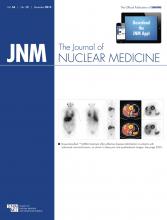TO THE EDITOR: In the April 2013 issue of The Journal of Nuclear Medicine, Wong and Piert (1) provided an excellent review on skeletal imaging with 99mTc-labeled diphosphonates and 18F-NaF. An important aspect of their paper was the use and the role of dynamic (3-phase) bone scanning. The authors stated that, for semiquantitative routine clinical applications, 18F-NaF PET (or PET/CT) could be performed similarly to a 3-phase bone scan by obtaining a short (0–10 min) dynamic acquisition of an area of interest. This acquisition would then represent both the angiographic flow and the soft-tissue phases in the region, enabling replacement of a 3-phase bone scan at a fraction of time. In agreement with this concept, we have recently published data on early dynamic 18F-FDG protocols in patients with chronic osteomyelitis (2).
For the purpose of a routine clinical approach, however, the review and current guidelines did not mention a possible use of 2-phase whole-body PET with 18F-NaF (1,3,4). This is an emerging modality with the potential to become a substitute for 2-phase bone scans for the identification of bone inflammation sites. The advantages of 2-phase whole-body 18F-NaF PET would be manifold: faster acquisition times, superior spatial resolution, exact quantification, and direct morphologic correlation with CT (if SPECT/CT is not available, as in our center).
As stated by Wong and Piert, 18F-NaF has much faster kinetics than 99mTc-labeled diphosphonates; therefore, soft-tissue scans must be obtained much more rapidly than in 2-phase bone scintigraphy. Indeed, fast early whole-body 18F-NaF PET scans have become feasible through the recent availability of scanners with enhanced detector sensitivity and expanded per-bed coverage due to a larger axial field of view. According to our experience (unpublished data, 2012 and 2013), these characteristics enable the acquisition of rapid whole-body scans immediately after administration of 18F-NaF, representing the soft-tissue phase in analogy to that provided by 2-phase bone scans.
In some clinical applications at our center—for example, with the aim of identifying distant or secondary bone inflammatory foci in addition to known local pathology—we used a Biograph mCT 40 4-ring scanner (Siemens; TrueV option with 21.6-cm axial field of view; 14 bed positions; 6 s/bed position, including bed-changing time) and obtained 2-phase 18NaF-PET scans within approximately 80 s after injection of 200–300 MBq of 18F-NaF. In the early phase, a typical soft-tissue distribution became apparent. The only partial limitation was a slight skeletal uptake in some cases (e.g., when scanning began with the feet, depiction of the upper ribs and acromioclavicular joints was marginal).
According to our experience, therefore, early and fast whole-body 18F-NaF PET scans are—in analogy to 2-phase bone scans—a valuable addition to the standard late technique. This option should be considered at least in cases of suspected disseminated inflammatory pathology.
Footnotes
Published online Nov. 6, 2013.
- © 2013 by the Society of Nuclear Medicine and Molecular Imaging, Inc.







